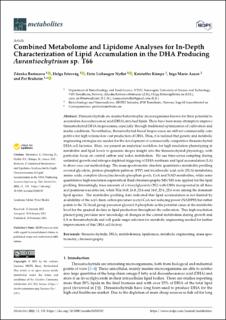| dc.description.abstract | Thraustochytrids are marine heterotrophic microorganisms known for their potential to accumulate docosahexaenoic acid (DHA)-enriched lipids. There have been many attempts to improve thraustochytrid DHA bioprocesses, especially through traditional optimization of cultivation and media conditions. Nevertheless, thraustochytrid-based bioprocesses are still not commercially competitive for high volume-low cost production of DHA. Thus, it is realized that genetic and metabolic engineering strategies are needed for the development of commercially competitive thraustochytrid DHA cell factories. Here, we present an analytical workflow for high resolution phenotyping at metabolite and lipid levels to generate deeper insight into the thraustochytrid physiology, with particular focus on central carbon and redox metabolism. We use time-series sampling during unlimited growth and nitrogen depleted triggering of DHA synthesis and lipid accumulation (LA) to show-case our methodology. The mass spectrometric absolute quantitative metabolite profiling covered glycolytic, pentose phosphate pathway (PPP) and tricarboxylic acid cycle (TCA) metabolites, amino acids, complete (deoxy)nucleoside phosphate pools, CoA and NAD metabolites, while semiquantitative high-resolution supercritical fluid chromatography MS/MS was applied for the lipid profiling. Interestingly, trace amounts of a triacylglycerols (TG) with DHA incorporated in all three acyl positions was detected, while TGs 16:0_16:0_22:6 and 16:0_22:6_22:6 were among the dominant lipid species. The metabolite profiling data indicated that lipid accumulation is not limited by availability of the acyl chain carbon precursor acetyl-CoA nor reducing power (NADPH) but rather points to the TG head group precursor glycerol-3-phosphate as the potential cause at the metabolite level for the gradual decline in lipid production throughout the cultivation. This high-resolution phenotyping provides new knowledge of changes in the central metabolism during growth and LA in thraustochytrids and will guide target selection for metabolic engineering needed for further improvements of this DHA cell factory. | en_US |

